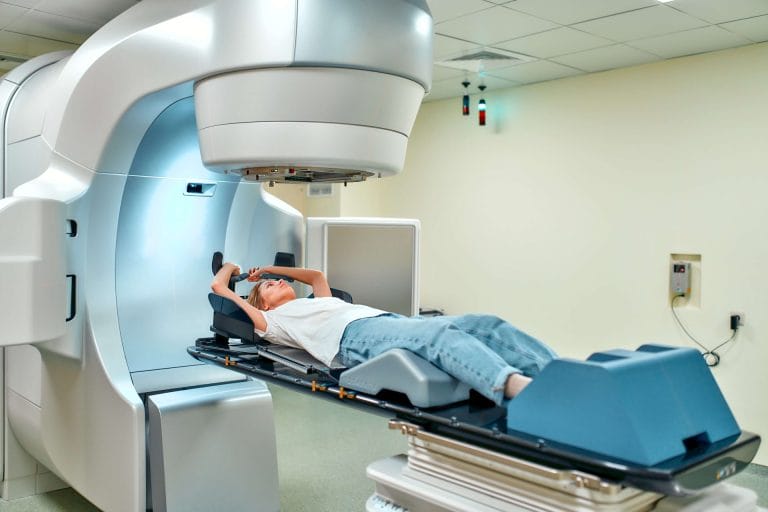
The symptoms of Parkinson’s disease progress over time, affecting the nervous system. You may experience tremors, stiff muscles, impeded movement, difficult balancing and changes in your speech. The type of symptoms you have and the severity depend on the stage of the disease, which begins as mild and moves to moderate and then advanced. While these symptoms can be frustrating and disruptive to daily life, managing Parkinson’s disease is possible. Learn about lifestyle changes to help you cope and maintain as much quality of life as possible.
View Parkinson’s Rehabilitation Services Offered by PAM Health
Parkinson’s Disease Symptoms: Are They Manageable?
Currently, there is no cure for Parkinson’s disease. The goal of treatment is to mitigate symptoms, such as the following.
- Tremors: About 80% of people with Parkinson’s disease will experience tremors, the involuntary shaking of different parts of the body. This symptom can affect the hands, feet, legs, jaw and mouth, and it typically occurs when you are at rest. Tremors usually start on one side of the body, although they can progress to affect both sides of the body. Because the tremors tend to go away with movement, they do not necessarily have a major impact on daily life.
Tremors can still be frustrating. They can cause you to drop things and make simple tasks like eating difficult. Some small adjustments can make living with tremors more manageable. For example, when doing something with your hands like eating or shaving, try sitting down instead of standing. Also, try bracing your elbows on a table while doing these things.
- Slowed movements: Parkinson’s disease can also cause slowed movements, known as bradykinesia. Bradykinesia can take a wide variety of forms, but it does affect all Parkinson’s disease patients. It may mean reduced motion in your arms as you walk, difficulty walking, trouble completing repetitive movements and limited facial expressions.
The severity of bradykinesia can increase over time. Exercise to stretch and strengthen your muscles is one potentially helpful approach to mitigating this symptom.
- Impaired balance: Difficulty maintaining your balance, also referred to as postural instability, is a common symptom of Parkinson’s disease. Balance issues tend to arise in the later stages of the disease. As Parkinson’s progresses, it affects the reflexes necessary for proper balance. Falls are a major concern with this symptom.
Falls can lead to injury, so it is essential to understand the severity of your impaired balance. You may need assistance from a cane or walker while walking. Physical therapy can also help manage postural instability.
- Stiff muscles: Stiff muscles are a common sign of something as simple as aging or a condition like arthritis, but it can also be a symptom of Parkinson’s disease. When someone living with Parkinson’s has stiff muscles, they are typically more rigid than what you would expect from age or arthritis. This symptom can contribute to the mobility challenges that come with Parkinson’s disease, and they can cause sleep difficulties. The condition can also affect the facial muscles.
The typical remedies you would think of for stiff muscles can also help with this symptom of Parkinson’s disease. Try a gentle stretching exercise, like yoga. Take a warm bath with Epsom salts. Some people may also find physical therapy helpful.
- Changes in speech and writing: In addition to mobility challenges, Parkinson’s disease can also impact spoken and written communication. The disease can make your voice quieter, slurred or mumbled. It can also affect your ability to add tonal variation to your words. You may find yourself speaking more slowly as you struggle to find the right words. Parkinson’s may also impact the fine motor skills necessary to write.
Some people with Parkinson’s disease have found working with a speech therapist to be beneficial. The cramped, tiny handwriting characteristic of Parkinson’s disease is known as micrographia. You can try to manage this by practicing your writing and using thick, weighted pens or pencils to write.

Lifestyle Changes for Managing Parkinson’s Disease
How do you manage Parkinson’s disease with the help of lifestyle changes? Here are three tips for changes you can make to help reduce your symptoms.
1. Exercise Regularly
Exercise is one of the most significant lifestyle changes you can make to help manage your mobility symptoms. Exercise can improve your balance and help keep you active throughout your day-to-day activities. It is essential to form exercise habits early in the disease’s progression, as doing so will help you maintain your quality of life. When you’re considering starting a new exercise program, ask your doctor for guidance. While you want to be active, you do not want to push yourself too hard and suffer an injury. Exercises that are a good option include the following.
- Yoga: Yoga can help improve your ability to walk and reduce tremors. There are many different forms of yoga, some fast-paced and high-intensity, and others slower and low-impact. Yoga can stretch stiff muscles, thus improving flexibility, and improve your posture, which may help manage instability issues.
- Pilates: Pilates and yoga are similar forms of exercise, but Pilates focuses more on strengthening muscles, while yoga is beneficial for improving your flexibility, balance and mind-body connection. Pilates helps improve coordination and balance, which are both crucial to your mobility. Like yoga, this is a low-impact exercise. Both yoga and Pilates can also help reduce anxiety, which your Parkinson’s symptoms may trigger.
- Dance: If you are looking for something a little less structured than the repetitive movements of yoga and Pilates, you might be interested in dance therapy. A dance therapist gets you moving with different exercises that work the entire body. This activity can also help with coordination and balance.
- Weights: Weight training is another form of exercise to consider. Lifting weights helps build up endurance and muscle strength, which are crucial elements of balance and mobility.
2. Eat a Healthy Diet
Maintaining your overall health is vital when you have Parkinson’s disease. Nutrition is an essential element of your overall well-being. A diet with plenty of fruits, vegetables, whole grains and lean protein is an ideal place to start. Eating a balanced diet helps you maintain a healthy weight and reduces the risk of other health concerns, such as high blood pressure and diabetes. Of course, you can still indulge in your favorite treats, but remember the rule of moderation. Limit your alcohol intake, and always talk to your doctor about any potential interactions with your medication.
3. Ensure You’re Getting Enough Sleep
Like a healthy diet, a regular sleep schedule is a crucial part of your overall well-being. Your symptoms may make sleeping a challenge. People with Parkinson’s can experience insomnia, sleep apnea and discomfort that keeps them awake. Try to set regular waking and sleep hours. Exercise during the day may also help you get enough rest at night. If necessary, talk to your doctor about safe sleep aids.

Tips for Starting Lifestyle Changes
How do you live with Parkinson’s disease? The answer is different for everyone. Adjusting to your symptoms and the lifestyle changes you need to make can be difficult. As you start adjusting your routine, keep these tips in mind.
- Take things at your pace: Forming new habits take time. Be patient with yourself and accept that improvements won’t happen overnight. If you need to make several lifestyle modifications, such as a healthier diet, a new exercise regimen and a new schedule, pick one and start there. Gradually adjust your schedule and stick to it. Over time, the changes will become a habit. Remember that you have resolved to do things differently for a reason, ultimately to help manage your symptoms and improve your quality of life.
- Set realistic goals: Lifestyle changes can help you with your symptoms, but they cannot stop or reverse the disease’s progression. When you’re setting your goals, keep them reasonable and attainable. Create an exercise schedule and make it your goal to stick to it. Work toward achieving a new pose in yoga or adding more reps to your weightlifting routine. Set a goal to try cooking something new for your healthy diet each week. Meeting goals can be rewarding, and it helps you continue with the lifestyle changes that can help manage your symptoms.
- Ask for help from your support system: When you first begin to experience symptoms and receive a Parkinson’s disease diagnosis, you may feel alone. But, you can reach out for help changing your lifestyle. Ask your family to help you achieve your goals. Try cooking a new meal with your spouse or your partner. Ask your kids or grandkids to spend an afternoon exercising with you. Talk to your friends about swapping recipes or starting an exercise group. Turning to the people who care about you is a great way to stay accountable to your goals and make progress.
Some people also find it helpful to talk to others who are experiencing similar situations. Look for a Parkinson’s disease support group in your area or join an online community. You can share experiences, hear stories from other people with similar symptoms and encourage one another to adapt to lifestyle changes.

Other Ways to Manage Parkinson’s Disease Symptoms
In addition to lifestyle changes, your doctor will likely discuss different medications with you. You may not immediately need prescription drugs to manage your symptoms, or your physician may prescribe you more than one type of medicine. Some of the medications commonly prescribed for Parkinson’s disease include the following.
- Levodopa: Levodopa is one of the most prevalent treatments for Parkinson’s disease. Pharmacists combine this drug with carbidopa, which helps curb nausea and delivers the medication to the brain, where it gets synthesized as dopamine. It comes in a few different formulations and dosages, which means it may have various brand names such as Parcopa or Sinemet. This drug can help control symptoms like bradykinesia, tremors and stiff muscles.
Like any medication, levodopa does have side effects. Over time, typically three to five years, levodopa can cause dyskinesia, a term used to describe involuntary jerky movement. It can affect the head, arms, legs, face or the entire body. There are medications to manage this side effect, as well as other treatment options.
- Dopamine agonists: Dopamine agonists are another medication indicated for the treatment of Parkinson’s disease. These drugs include pramipexole, ropinirole, rotigotine and apomorphine. Your doctor may prescribe a dopamine agonist in combination with levodopa or on its own. In addition to a positive effect on the motor symptoms associated with Parkinson’s disease, dopamine agonists may also help manage sleep and mood issues.
Side effects of dopamine agonists may include nausea, dizziness, sleep changes, swelling of the legs and hallucinations, among others.
- COMT inhibitors: Physicians don’t prescribe COMT inhibitors on their own to treat Parkinson’s disease. Rather, they help prolong the action of levodopa, the effects of which can begin to wear off more quickly over time. COMT inhibitors include entacapone, opicapone and tolcapone. Your doctor will determine if and when COMT inhibitors are appropriate and at what dose.
This type of medication may increase the side effects associated with levodopa, such as dyskinesia. Diarrhea, discolored urine and liver damage are also potential side effects of COMT inhibitors.
- MAO-B inhibitors: Monoamine oxidase type B (MAO-B) inhibitors include selegiline, rasagiline and safinamide. These drugs can play a role in managing the motor symptoms of Parkinson’s disease. MAO-B inhibitors can be a stand-alone treatment in the early stages of Parkinson’s and alongside levodopa in the later stages. Like the other medications used to treat Parkinson’s, MAO-B inhibitors are available in varying doses.
The possible side effects of MAO-B inhibitors include dry mouth, constipation, nausea and lightheadedness.
You and your doctor will discuss your symptoms and the stage of your disease before ultimately deciding on the best medication or medications for you.
Find a PAM Health Location Near You

The Best Care for Parkinson’s Patients
A Parkinson’s disease diagnosis is life-changing, but that doesn’t mean you have to stop enjoying life. You will need to make significant changes, and some days will be better than others. However, you can manage your symptoms with lifestyle adjustments and medication. Post Acute Medical has a rehabilitation program designed specifically for Parkinson’s patients. Our comprehensive, holistic approach offers relief for all your symptoms. We also provide support, education and therapy for the loved ones who will help with your care plan. Take some time to look at our Parkinson’s disease resources. Our compassionate team has specialized training to improve your understanding of how to manage Parkinson’s disease and move forward with your life.


